Land Use–Future Climate Coupling Mechanism Analysis of Regional Agricultural Drought Spatiotemporal Patterns
Abstract
1. Introduction
2. Materials and Methods
2.1. Research Area Overview
2.2. Data Source: Preprocessing
2.3. Research Framework
2.4. SWAT Model Calibration and Validation
2.5. PLUS Model
2.6. CMIP6 Climate Model
2.7. Agricultural Drought SSMI
2.8. Runs Theory
3. Results
3.1. SWAT Model Parameter Calibration and Validation
3.2. CMIP6 Global Climate Model Analysis
3.2.1. Comparison of Taylor Diagrams Between Meteorological Models and Ensemble Average Models
3.2.2. Future Climate Change Scenarios
3.3. Land Use Change
3.4. Prediction of Soil Moisture Under Changing Weather Conditions
3.5. Drought Analysis at Different Scales
3.5.1. SSMI-1 and SSMI-12 Drought Analysis
3.5.2. Trends and Sudden Changes in Land Use Before and After
4. Discussion
5. Conclusions
Author Contributions
Funding
Institutional Review Board Statement
Informed Consent Statement
Data Availability Statement
Conflicts of Interest
References
- Tang, R.; Peng, Z.; Liu, M.; Li, Z.-L.; Jiang, Y.; Hu, Y.; Huang, L.; Wang, Y.; Wang, J.; Jia, L.; et al. Spatial-Temporal Patterns of Land Surface Evapotranspiration from Global Products. Remote Sens. Environ. 2024, 304, 114066. [Google Scholar] [CrossRef]
- Li, L.; Qian, R.; Liu, W.; Wang, W.; Biederman, J.A.; Zhang, B.; Kang, X.; Wen, F.; Ran, Q.; Zheng, Z.; et al. Drought Timing Influences the Sensitivity of a Semiarid Grassland to Drought. Geoderma 2022, 412, 115714. [Google Scholar] [CrossRef]
- Sutanto, S.J.; Van Lanen, H.A.J. Streamflow Drought: Implication of Drought Definitions and Its Application for Drought Forecasting. Hydrol. Earth Syst. Sci. 2021, 25, 3991–4023. [Google Scholar] [CrossRef]
- Kyatengerwa, C.; Kim, D.; Choi, M. A National-Scale Drought Assessment in Uganda Based on Evapotranspiration Deficits from the Bouchet Hypothesis. J. Hydrol. 2020, 580, 124348. [Google Scholar] [CrossRef]
- Chang, S.; Chen, H.; Wu, B.; Nasanbat, E.; Yan, N.; Davdai, B. A Practical Satellite-Derived Vegetation Drought Index for Arid and Semi-Arid Grassland Drought Monitoring. Remote Sens. 2021, 13, 414. [Google Scholar] [CrossRef]
- Damarla, G.; Kavuri, N.C. Comparison of a Decade’s Data between Lst and Ndvi Data for Agricultural Drought Analysis in Rayalaseema Region, Ap, India. IOP Conf. Ser. Mater. Sci. Eng. 2021, 1136, 012009. [Google Scholar] [CrossRef]
- Zhang, B.; He, C. A Modified Water Demand Estimation Method for Drought Identification over Arid and Semiarid Regions. Agric. For. Meteorol. 2016, 230–231, 58–66. [Google Scholar] [CrossRef]
- Senapati, U.; Das, T.K. Enhancing Agricultural Drought Monitoring with the Integrated Agricultural Drought Index (Iadi): A Multi-Source Remote Sensing Approach. Adv. Space Res. 2025, 75, 8599–8626. [Google Scholar] [CrossRef]
- Alahacoon, N.; Edirisinghe, M.; Ranagalage, M. Satellite-Based Meteorological and Agricultural Drought Monitoring for Agricultural Sustainability in Sri Lanka. Sustainability 2021, 13, 3427. [Google Scholar] [CrossRef]
- Lee, J.-W.; Hong, E.-M.; Kim, J.-U.; Jang, W.-J.; Jung, C.-G.; Kim, S.-J. Evaluation of Agricultural Drought in South Korea Using Socio-Economic Drought Information. Int. J. Disaster Risk Reduct. 2022, 74, 102936. [Google Scholar] [CrossRef]
- Kuwayama, Y.; Thompson, A.; Bernknopf, R.; Zaitchik, B.; Vail, P. Estimating the Impact of Drought on Agriculture Using the Us Drought Monitor. Am. J. Agric. Econ. 2019, 101, 193–210. [Google Scholar] [CrossRef]
- Bageshree, K.; Abhishek; Kinouchi, T. A Multivariate Drought Index for Seasonal Agriculture Drought Classification in Semiarid Regions. Remote Sens. 2022, 14, 3891. [Google Scholar] [CrossRef]
- García-León, D.; Standardi, G.; Staccione, A. An Integrated Approach for the Estimation of Agricultural Drought Costs. Land Use Policy 2021, 100, 104923. [Google Scholar] [CrossRef]
- Wu, B.; Ma, Z.; Yan, N. Agricultural Drought Mitigating Indices Derived from the Changes in Drought Characteristics. Remote Sens. Environ. 2020, 244, 111813. [Google Scholar] [CrossRef]
- Dai, M.; Huang, S.; Huang, Q.; Leng, G.; Guo, Y.; Wang, L.; Fang, W.; Li, P.; Zheng, X. Assessing Agricultural Drought Risk and Its Dynamic Evolution Characteristics. Agric. Water Manag. 2020, 231, 106003. [Google Scholar] [CrossRef]
- Yin, G.; He, W.; Liu, X.; Xia, Y.; Zhang, H. Wetting or Greening? Probing the Global Trends in Vegetation Condition Index (Vci). Int. J. Appl. Earth Obs. Geoinf. 2024, 129, 103822. [Google Scholar] [CrossRef]
- Ren, H.; Du, L.; Peng, C.; Yang, J.; Gao, W. The Composite Drought Index Incorporated Solar-Induced Chlorophyll Fluorescence Enhances the Monitoring Capability of Short-Term Drought. J. Hydrol. 2024, 637, 131361. [Google Scholar] [CrossRef]
- Li, M.; Chu, R.; Islam, A.R.M.T. A New Drought Fluorescence Monitoring Index Established for Detecting Drought Evolution Characteristics in the Middle and Lower Reaches of the Yangtze River, China During 2001–2020. IEEE Trans. Geosci. Remote Sens. 2023, 61, 4405613. [Google Scholar] [CrossRef]
- Bento, V.A.; Gouveia, C.M.; DaCamara, C.C.; Trigo, I.F. A Climatological Assessment of Drought Impact on Vegetation Health Index. Agric. For. Meteorol. 2018, 259, 286–295. [Google Scholar] [CrossRef]
- Muthuvel, D.; Sivakumar, B. Cascading Spatial Drought Network: A Complex Networks Approach to Track Propagation of Meteorological Droughts to Agricultural Droughts. J. Environ. Manag. 2024, 370, 122511. [Google Scholar] [CrossRef]
- Fawen, L.; Manjing, Z.; Yong, Z.; Rengui, J. Influence of Irrigation and Groundwater on the Propagation of Meteorological Drought to Agricultural Drought. Agric. Water Manag. 2023, 277, 108099. [Google Scholar] [CrossRef]
- Parsons, D.J.; Rey, D.; Tanguy, M.; Holman, I.P. Regional Variations in the Link between Drought Indices and Reported Agricultural Impacts of Drought. Agric. Syst. 2019, 173, 119–129. [Google Scholar] [CrossRef]
- Yoon, D.-H.; Nam, W.-H.; Lee, H.-J.; Hong, E.-M.; Feng, S.; Wardlow, B.D.; Tadesse, T.; Svoboda, M.D.; Hayes, M.J.; Kim, D.-E. Agricultural Drought Assessment in East Asia Using Satellite-Based Indices. Remote Sens. 2020, 12, 444. [Google Scholar] [CrossRef]
- Nigatu, Z.M.; You, W.; Melesse, A.M. Drought Dynamics in the Nile River Basin: Meteorological, Agricultural, and Groundwater Drought Propagation. Remote Sens. 2024, 16, 919. [Google Scholar] [CrossRef]
- Sanchez, N.; González-Zamora, Á.; Martínez-Fernández, J.; Piles, M.; Pablos, M. Integrated Remote Sensing Approach to Global Agricultural Drought Monitoring. Agric. For. Meteorol. 2018, 259, 141–153. [Google Scholar] [CrossRef]
- Yu, Z.; Ciais, P.; Piao, S.; Houghton, R.A.; Lu, C.; Tian, H.; Agathokleous, E.; Kattel, G.R.; Sitch, S.; Goll, D.; et al. Forest Expansion Dominates China’s Land Carbon Sink since 1980. Nat. Commun. 2022, 13, 5374. [Google Scholar] [CrossRef] [PubMed]
- Jin, G.; Peng, J.; Zhang, L.; Zhang, Z. Understanding Land for High-Quality Development. J. Geogr. Sci. 2023, 33, 217–221. [Google Scholar] [CrossRef]
- The Cmip6 Landscape. Nat. Clim. Chang. 2019, 9, 727. [CrossRef]
- Abalos, M.; Calvo, N.; Benito-Barca, S.; Garny, H.; Hardiman, S.C.; Lin, P.; Andrews, M.B.; Butchart, N.; Garcia, R.; Orbe, C.; et al. The Brewer-Dobson Circulation in Cmip6. Atmos. Chem. Phys. 2021, 21, 13571–13591. [Google Scholar] [CrossRef]
- Grise, K.M.; Davis, S.M. Hadley Cell Expansion in Cmip6 Models. Atmos. Chem. Phys. 2020, 20, 5249–5268. [Google Scholar] [CrossRef]
- Zhao, Y.; Sun, D.-Z. Enso Asymmetry in Cmip6 Models. J. Clim. 2022, 35, 5555–5572. [Google Scholar] [CrossRef]
- Gier, B.K.; Schlund, M.; Friedlingstein, P.; Jones, C.D.; Jones, C.; Zaehle, S.; Eyring, V. Representation of the Terrestrial Carbon Cycle in Cmip6. Biogeosciences 2024, 21, 5321–5360. [Google Scholar] [CrossRef]
- Back, S.-Y.; Kim, D.; Son, S.-W. Mjo Diversity in Cmip6 Models. J. Clim. 2024, 37, 4835–4850. [Google Scholar] [CrossRef]
- Nie, Y.; Lin, X.; Yang, Q.; Liu, J.; Chen, D.; Uotila, P. Differences between the Cmip5 and Cmip6 Antarctic Sea Ice Concentration Budgets. Geophys. Res. Lett. 2023, 50, e2023GL105265. [Google Scholar] [CrossRef]
- Coburn, J.; Pryor, S.C. Differential Credibility of Climate Modes in Cmip6. J. Clim. 2021, 34, 8145–8164. [Google Scholar] [CrossRef]
- Li, X.; Tan, J.; Wang, X.; Han, G.; Qian, Z.; Li, H.; Wang, L.; Niu, G. Responses of Spring Wheat Yield and Growth Period to Different Future Climate Change Models in the Yellow River Irrigation Area Based on Cmip6 and Wofost Models. Agric. For. Meteorol. 2024, 353, 110071. [Google Scholar] [CrossRef]
- Wang, Z.; Li, X.; Mao, Y.; Li, L.; Wang, X.; Lin, Q. Dynamic Simulation of Land Use Change and Assessment of Carbon Storage Based on Climate Change Scenarios at the City Level: A Case Study of Bortala, China. Ecol. Indic. 2022, 134, 108499. [Google Scholar] [CrossRef]
- Cai, Y.; Zhang, F.; Shi, J.; Johnson, V.C.; Ahmed, Z.; Wang, J.; Wang, W. Enhancing Swat Model with Modified Method to Improve Eco-Hydrological Simulation in Arid Region. J. Clean. Prod. 2023, 403, 136891. [Google Scholar] [CrossRef]
- Castaneda-Gonzalez, M.; Poulin, A.; Romero-Lopez, R.; Turcotte, R. Hydrological Models Weighting for Hydrological Projections: The Impacts on Future Peak Flows. J. Hydrol. 2023, 625, 130098. [Google Scholar] [CrossRef]
- Castellanos-Osorio, G.; López-Ballesteros, A.; Pérez-Sánchez, J.; Senent-Aparicio, J. Disaggregated Monthly Swat+ Model Versus Daily Swat+ Model for Estimating Environmental Flows in Peninsular Spain. J. Hydrol. 2023, 623, 129837. [Google Scholar] [CrossRef]
- Sánchez-Gómez, A.; Martínez-Pérez, S.; Pérez-Chavero, F.M.; Molina-Navarro, E. Optimization of a Swat Model by Incorporating Geological Information through Calibration Strategies. Optim. Eng. 2022, 23, 2203–2233. [Google Scholar] [CrossRef]
- Wang, Y.; Zhu, S.; Yuan, L.; Deng, R. An Automatic Parameter Calibration Method for Theswatmodel in Runoff Simulation. RIVER Res. Appl. 2020, 36, 1321–1333. [Google Scholar] [CrossRef]
- Rajat; Athira, P. Calibration of Hydrological Models Considering Process Interdependence: A Case Study of Swat Model. Environ. Model. Softw. 2021, 144, 105131. [Google Scholar] [CrossRef]
- Lin, X.; Fu, H. Multi-Scenario Simulation Analysis of Cultivated Land Based on Plus Model-a Case Study of Haikou, China. Front. Ecol. Evol. 2023, 11, 1197419. [Google Scholar] [CrossRef]
- Xu, L.; Liu, X.; Tong, D.; Liu, Z.; Yin, L.; Zheng, W. Forecasting Urban Land Use Change Based on Cellular Automata and the Plus Model. Land 2022, 11, 652. [Google Scholar] [CrossRef]
- Lu, C.; Qi, X.; Zheng, Z.; Jia, K. Plus-Model Based Multi-Scenario Land Space Simulation of the Lower Yellow River Region and Its Ecological Effects. Sustainability 2022, 14, 6942. [Google Scholar] [CrossRef]
- Liu, J.; Hou, Y.; Li, F.; Zheng, B.; Chen, Z.; Zheng, F.; Zhang, X.; Yu, R. Land Use Change Projection and Driving Factors Exploration in Hainan Island Based on the Plus Model. Front. Mar. Sci. 2025, 12, 1534508. [Google Scholar] [CrossRef]
- te Wierik, S.A.; Cammeraat, E.L.H.; Gupta, J.; Artzy-Randrup, Y.A. Reviewing the Impact of Land Use and Land-Use Change on Moisture Recycling and Precipitation Patterns. Water Resour. Res. 2021, 57, e2020WR029234. [Google Scholar] [CrossRef]
- Chen, S.; Yuan, X. The Timing of Detectable Increases in Seasonal Soil Moisture Droughts under Future Climate Change. Earth’s Future 2024, 12, e2023EF004174. [Google Scholar] [CrossRef]
- Nepal, D.; Parajuli, P.B.; Ouyang, Y.; To, S.F.; Wijewardane, N. Assessing Hydrological and Water Quality Responses to Dynamic Landuse Change at Watershed Scale in Mississippi. J. Hydrol. 2023, 625, 129983. [Google Scholar] [CrossRef]
- Liu, Y.; Fu, C.; Huang, H.; Zheng, S.; Tu, X. Response of Ecosystem Services to Land Use–Land Cover Change in Poyang Lake Basin, China, under Multiple Scenarios. J. Water Resour. Plan. Manag. 2024, 150, 05024007. [Google Scholar] [CrossRef]
- Zhang, Y.; Tang, C.; Ye, A.; Zheng, T.; Nie, X.; Tu, A.; Zhu, H.; Zhang, S. Impacts of Climate and Land-Use Change on Blue and Green Water: A Case Study of the Upper Ganjiang River Basin, China. Water 2020, 12, 2661. [Google Scholar] [CrossRef]
- Dangol, S.; Zhang, X.; Liang, X.-Z.; Anderson, M.; Crow, W.; Lee, S.; Moglen, G.E.; McCarty, G.W. Multivariate Calibration of the Swat Model Using Remotely Sensed Datasets. Remote Sens. 2023, 15, 2417. [Google Scholar] [CrossRef]
- Pignotti, G.; Rathjens, H.; Cibin, R.; Chaubey, I.; Crawford, M. Comparative Analysis of Hru and Grid-Based Swat Models. Water 2017, 9, 272. [Google Scholar] [CrossRef]
- Abbas, T.; Hussain, F.; Nabi, G.; Boota, M.W. Uncertainty Evaluation of Swat Model for Snowmelt Runoff in a Himalayan Watershed. Terr. Atmos. Ocean. Sci. 2019, 30, 1–15. [Google Scholar] [CrossRef]
- Haleem, K.; Khan, A.U.; Khan, J.; Ghanim, A.A.J.; Al-Areeq, A.M. Evaluating Future Streamflow Patterns under Ssp245 Scenarios: Insights from Cmip6. Sustainability 2023, 15, 16117. [Google Scholar] [CrossRef]
- McKee, T.B.; Doesken, N.J.; Kleist, J. The Relationship of Drought Frequency and Duration to Time Scales. In Proceedings of the 8th Conference on Applied Climatology, Anaheim, CA, USA, 17–22 January 1993. [Google Scholar]
- Xu, L.; Chen, N.; Yang, C.; Zhang, C.; Yu, H. A Parametric Multivariate Drought Index for Drought Monitoring and Assessment under Climate Change. Agric. For. Meteorol. 2021, 310, 108657. [Google Scholar] [CrossRef]
- Krueger, E.S.; Ochsner, T.E.; Quiring, S.M. Development and Evaluation of Soil Moisture-Based Indices for Agricultural Drought Monitoring. Agron. J. 2019, 111, 1392–1406. [Google Scholar] [CrossRef]
- Modanesi, S.; Massari, C.; Camici, S.; Brocca, L.; Amarnath, G. Do Satellite Surface Soil Moisture Observations Better Retain Information About Crop-Yield Variability in Drought Conditions? Water Resour. Res. 2020, 56, e2019WR025855. [Google Scholar] [CrossRef]
- Tramblay, Y.; Seguí, P.Q. Estimating Soil Moisture Conditions for Drought Monitoring with Random Forests and a Simple Soil Moisture Accounting Scheme. Nat. Hazards Earth Syst. Sci. 2022, 22, 1325–1334. [Google Scholar] [CrossRef]
- Dorigo, W.A.; Xaver, A.; Vreugdenhil, M.; Gruber, A.; Hegyiová, A.; Sanchis-Dufau, A.D.; Zamojski, D.; Cordes, C.; Wagner, W.; Drusch, M. Global Automated Quality Control of in Situ Soil Moisture Data from the International Soil Moisture Network. Vadose Zone J. 2013, 12, vzj2012.0097. [Google Scholar] [CrossRef]
- Fan, J.; Xu, F.; Sun, X.; Dong, W.; Ma, X.; Liu, G.; Cheng, Y.; Wang, H. Construction and Application of Hydrometeorological Comprehensive Drought Index in Weihe River. Atmosphere 2022, 13, 610. [Google Scholar] [CrossRef]
- Wen, Y.; Zhou, L.; Kang, L.; Chen, H.; Guo, J. Drought Risk Analysis Based on Multivariate Copula Function in Henan Province, China. Geomat. Nat. Hazards Risk 2023, 14, 2223344. [Google Scholar] [CrossRef]
- Lin, H.; Yu, Z.; Chen, X.; Gu, H.; Ju, Q.; Shen, T. Spatial-Temporal Dynamics of Meteorological and Soil Moisture Drought on the Tibetan Plateau: Trend, Response, and Propagation Process. J. Hydrol. 2023, 626, 130211. [Google Scholar] [CrossRef]
- Wang, Y.; Deng, F.; Cai, Y.; Zhao, Y. Spatial and Temporal Change in Meteorological Drought in Gansu Province from 1969 to 2018 Based on Reof. Sustainability 2023, 15, 9014. [Google Scholar] [CrossRef]
- Kim, B.S.; Chang, I.G.; Sung, J.H.; Han, H.J. Projection in Future Drought Hazard of South Korea Based on Rcp Climate Change Scenario 8.5 Using Spei. Adv. Meteorol. 2016, 2016, 4148710. [Google Scholar] [CrossRef]
- Mohsin, M.; Adnan, S. Probabilistic Modelling of Interarrival Time of Drought for Different Operational Drought Indices Used in Pakistan. Int. J. Climatol. 2023, 43, 6851–6865. [Google Scholar] [CrossRef]
- Vergni, L.; Todisco, F.; Mannocchi, F. Analysis of Agricultural Drought Characteristics through a Two-Dimensional Copula. Water Resour. Manag. 2015, 29, 4203–4204. [Google Scholar] [CrossRef]
- Vinatier, F.; Arnaiz, A.G. Using High-Resolution Multitemporal Imagery to Highlight Severe Land Management Changes in Mediterranean Vineyards. Appl. Geogr. 2018, 90, 115–122. [Google Scholar] [CrossRef]
- Wang, X.; Liu, G.; Xiang, A.; Xiao, S.; Lin, D.; Lin, Y.; Lu, Y. Terrain Gradient Response of Landscape Ecological Environment to Land Use and Land Cover Change in the Hilly Watershed in South China. Ecol. Indic. 2023, 146, 109797. [Google Scholar] [CrossRef]
- Chen, S.; Huang, J.; Huang, C., Jr. Improving Daily Streamflow Simulations for Data-Scarce Watersheds Using the Coupled Swat-Lstm Approach. J. Hydrol. 2023, 622, 129734. [Google Scholar] [CrossRef]
- Sun, J.; Yan, H.; Bao, Z.; Wang, G. Investigating Impacts of Climate Change on Runoff from the Qinhuai River by Using the Swat Model and Cmip6 Scenarios. Water 2022, 14, 1778. [Google Scholar] [CrossRef]
- Wang, S.; Zhang, H.-J.; Wang, T.-T.; Hossain, S. Simulating Runoff Changes and Evaluating under Climate Change Using Cmip6 Data and the Optimal Swat Model: A Case Study. Sci. Rep. 2024, 14, 23228. [Google Scholar] [CrossRef]
- Wang, Q.; Xia, J.; Zhang, X.; She, D.; Liu, J.; Li, P. Multi-Scenario Integration Comparison of Cmads and Tmpa Datasets for Hydro-Climatic Simulation over Ganjiang River Basin, China. Water 2020, 12, 3243. [Google Scholar] [CrossRef]
- Liang, X.; Guan, Q.; Clarke, K.C.; Liu, S.; Wang, B.; Yao, Y. Understanding the Drivers of Sustainable Land Expansion Using a Patch-Generating Land Use Simulation (Plus) Model: A Case Study in Wuhan, China. Comput. Environ. Urban Syst. 2021, 85, 101569. [Google Scholar] [CrossRef]
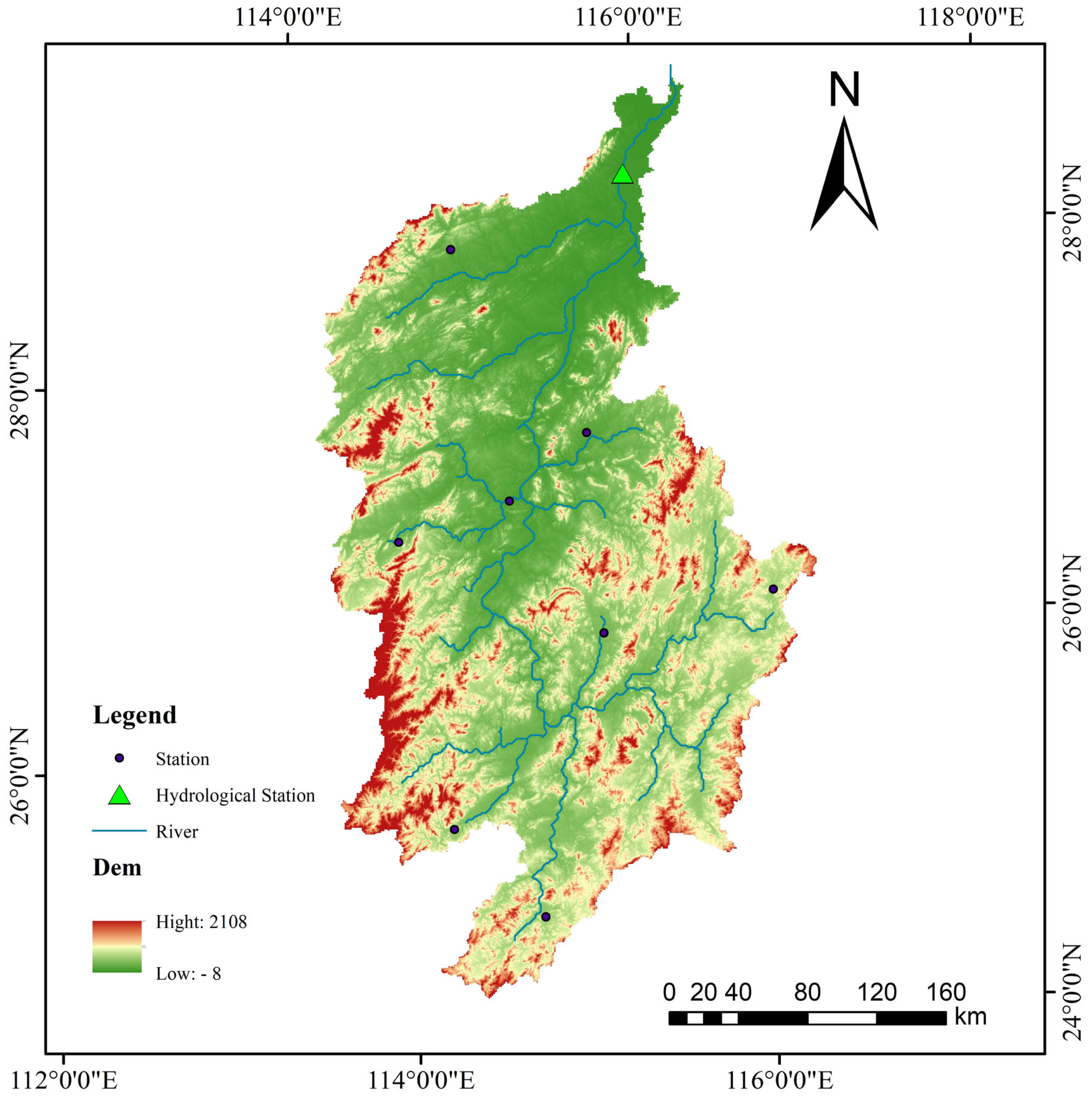
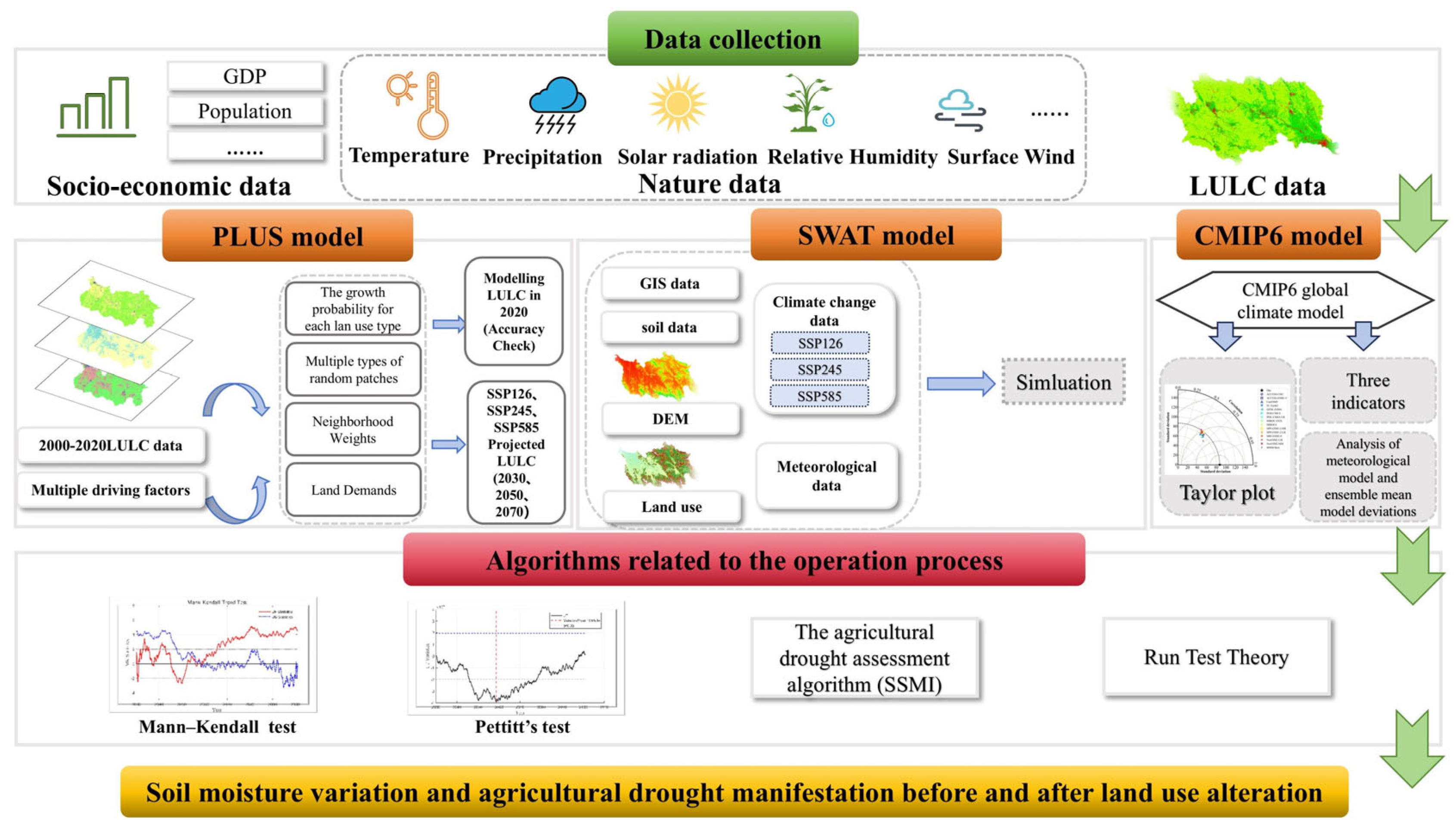
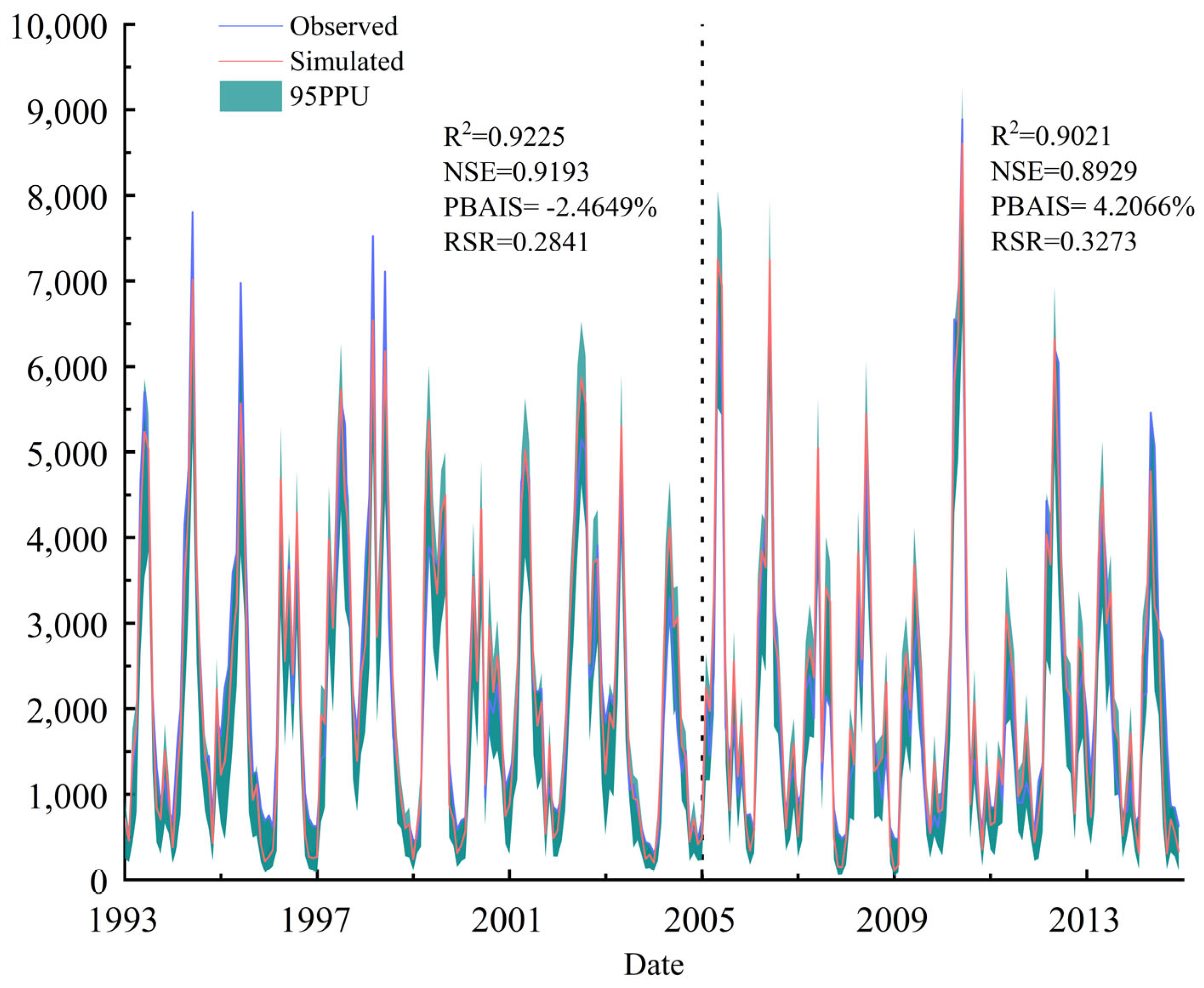


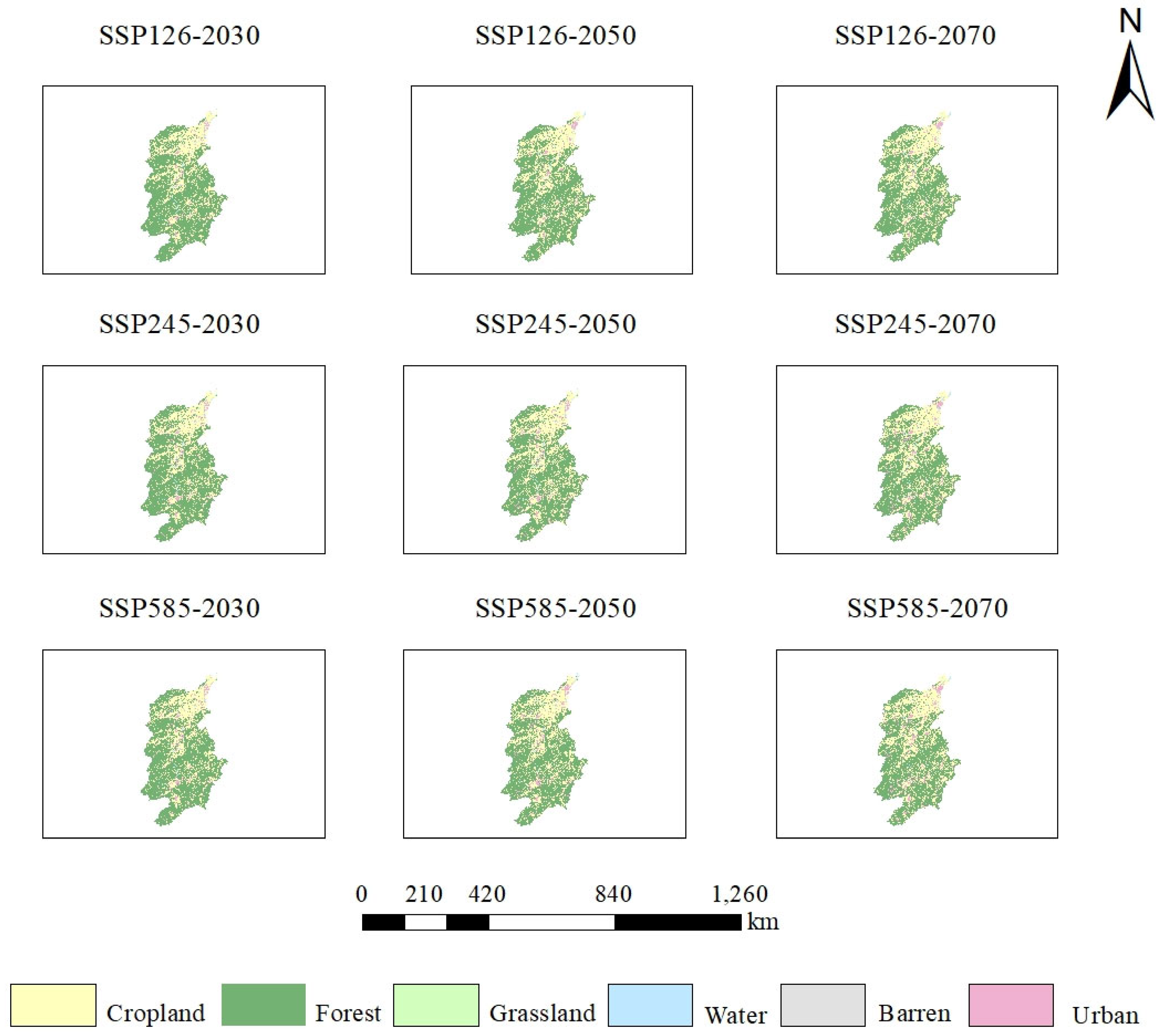
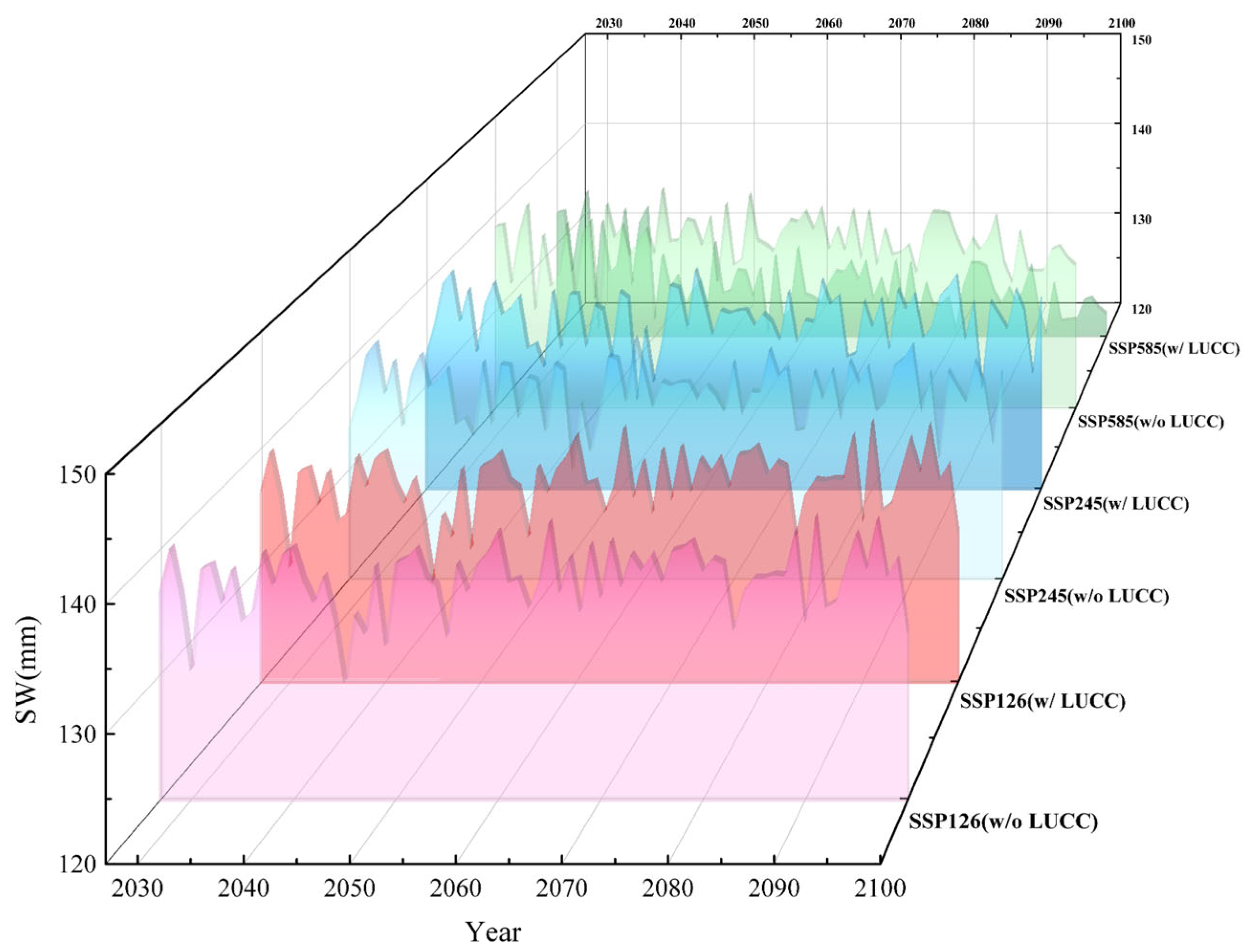
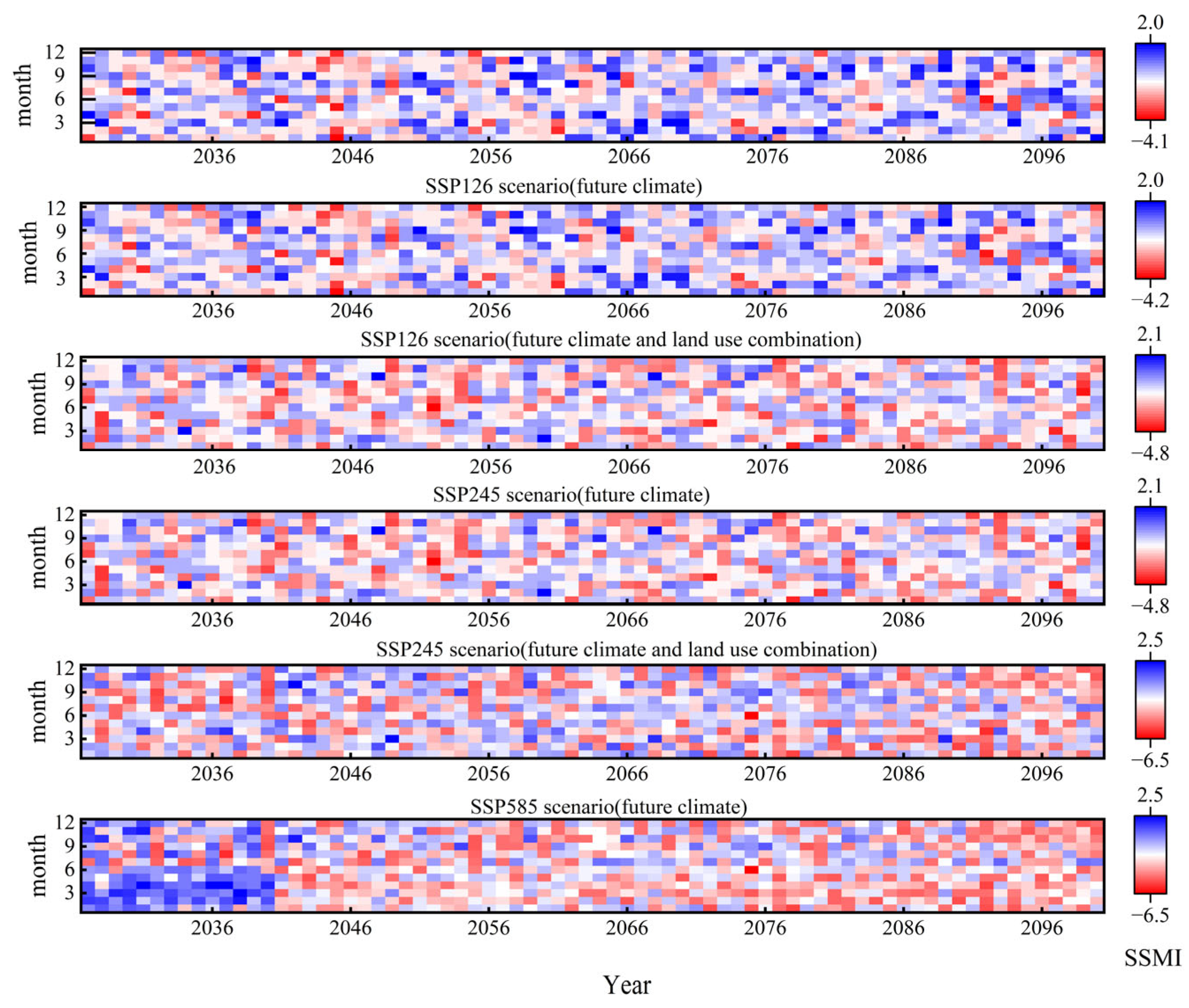
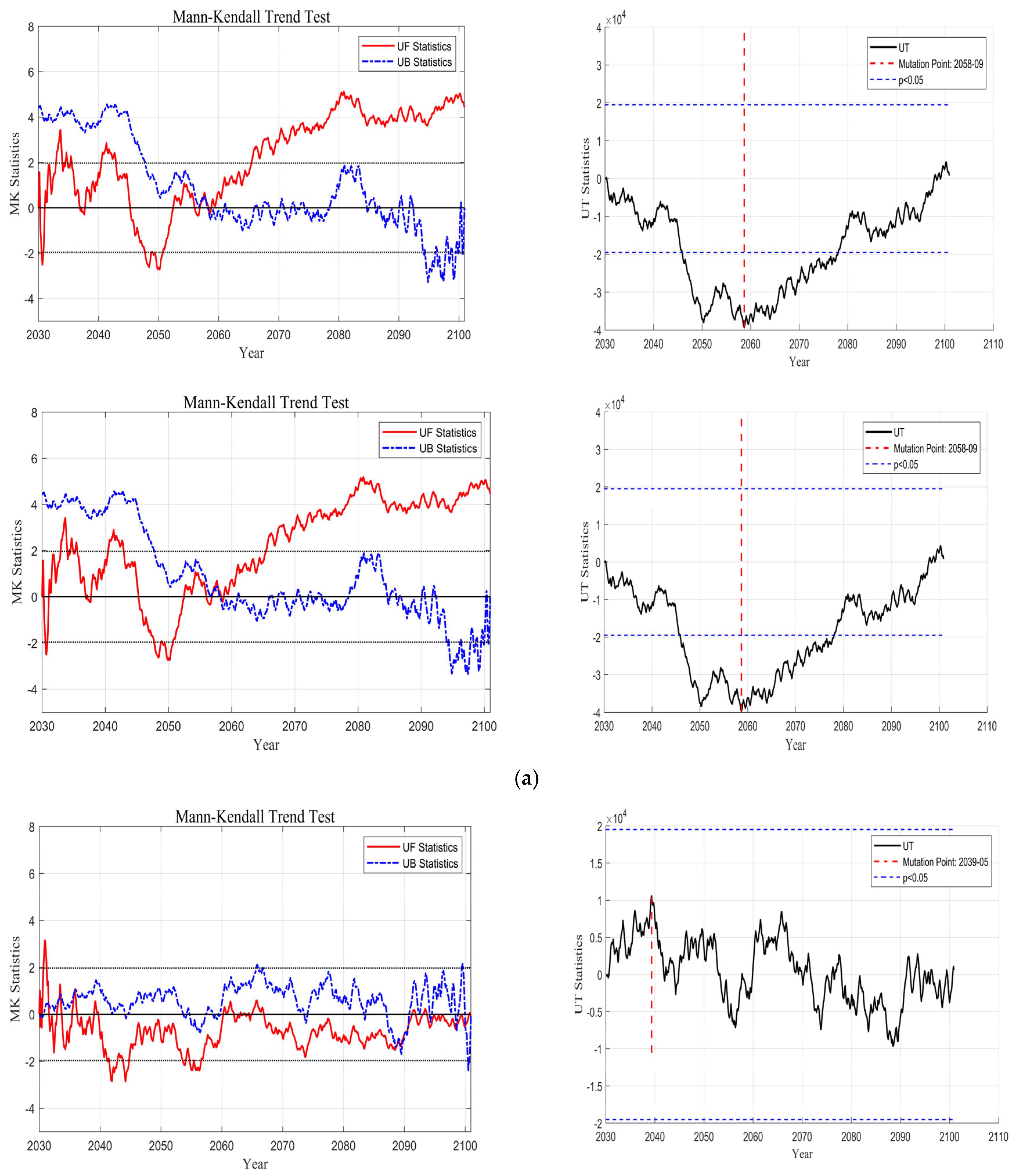
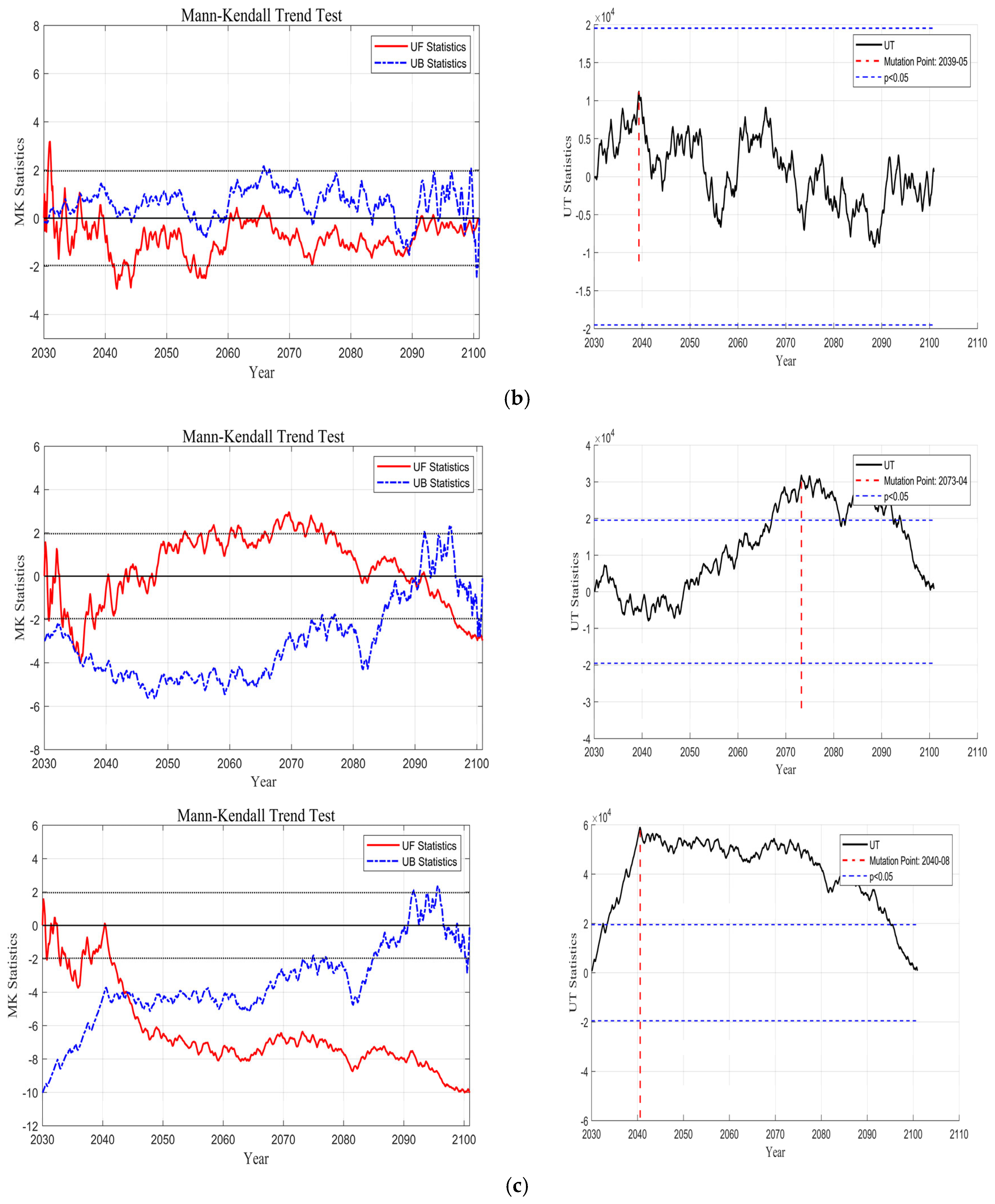
| Data Type | Data Name | Year | Data Source |
|---|---|---|---|
| Basic data | A dataset of multi-period remote sensing monitoring of land use in China CNLUCC) | 2000, 2010, and 2020 | Chinese Academy of Sciences Center for Resources and Environmental Science and Data (https://www.resdc.cn/, accessed on 1 July 2025) |
| hydrological station data | 2020 | Earth Resources Data Cloud Platform (www.gis5g.com, accessed on 1 July 2025) | |
| Natural element | ASTER GDEM V3 (X1) | 2015 | Geospatial data cloud (https://www.gscloud.cn/, accessed on 1 July 2025) |
| slope (X2) | Calculated from DEM slope | ||
| Distance from water (X3) | 2015 | OpenStreetMap (https://www.openstreetmap.org, accessed on 1 July 2025) | |
| Temperature/forecast (X4) | 2030, 2050, and 2070 | Chinese Academy of Sciences Center for Resources and Environmental Science and Data (https://www.resdc.cn/, accessed on 1 July 2025) | |
| Precipitation/future precipitation (X5) | CMIP6 database (https://www.nccs.nasa.gov, accessed on 1 July 2025) | ||
| Socio-economic factor | Population/future population (X6) | 2015, 2030, 2050, and 2070 | Chinese Academy of Sciences Center for Resources and Environmental Science and Data (https://www.resdc.cn/, accessed on 1 July 2025) |
| Scientific data bank (https://cstr.cn/31253.11.sciencedb.01683, accessed on 1 July 2025) | |||
| GDP/future GDP (X7) | Chinese Academy of Sciences Center for Resources and Environmental Science and Data (https://www.resdc.cn/, accessed on 1 July 2025) | ||
| Distance between government seat (city or county level) (X8 and X9) | 2015 | National Geographic Information Resources Catalog Service System (https://www.webmap.cn/, accessed on 1 July 2025) | |
| Nature reserve (X10) | 2015 | OpenStreetMap (https://www.openstreetmap.org, accessed on 1 July 2025) | |
| Distance to primary, secondary, and tertiary roads (X11, X12, and X13) | |||
| Night light (X14) |
| Pattern Name | Country | Spatial Resolution | Pattern Name | Country | Spatial Resolution |
|---|---|---|---|---|---|
| ACCESS-CM2 | Australia | 0.25° × 0.25° | EC-Earth3 | Europe | 0.25° × 0.25° |
| ACCESS-ESM1-5 | IPSL-CM6A-LR | ||||
| NorESM2-LM | Norway | MIROC6 | Japan | ||
| NorESM2-MM | MIROC-ES2L | ||||
| MPI-ESM1-2-HR | Germany | MRI-ESM2-0 | |||
| MPI-ESM1-2-LR | GFDL-ESM4 | United States | |||
| INM-CM4-8 | Russia | CanESM5 | Canada |
| Land Use Type | Field Weight | SSP1-2.6 Scenario | SSP2-4.5 Scenario | SSP5-8.5 Scenario | |||||||||||||||
|---|---|---|---|---|---|---|---|---|---|---|---|---|---|---|---|---|---|---|---|
| C | F | G | W | B | U | C | F | G | W | B | U | C | F | G | W | B | U | ||
| C | 1 | 1 | 0 | 1 | 1 | 0 | 1 | 1 | 0 | 1 | 1 | 1 | 1 | 1 | 0 | 0 | 0 | 1 | 1 |
| F | 0.416 | 1 | 1 | 1 | 0 | 0 | 1 | 0 | 1 | 0 | 0 | 0 | 1 | 1 | 1 | 0 | 0 | 0 | 1 |
| G | 0.004 | 1 | 0 | 1 | 1 | 0 | 0 | 1 | 0 | 1 | 1 | 1 | 1 | 1 | 0 | 1 | 1 | 1 | 1 |
| W | 0.069 | 0 | 0 | 0 | 1 | 0 | 0 | 0 | 0 | 0 | 1 | 1 | 1 | 1 | 0 | 0 | 1 | 1 | 0 |
| B | 0.001 | 1 | 1 | 1 | 1 | 1 | 1 | 1 | 1 | 1 | 1 | 1 | 1 | 1 | 1 | 1 | 1 | 1 | 1 |
| U | 0.268 | 0 | 0 | 0 | 0 | 0 | 1 | 0 | 0 | 1 | 0 | 0 | 1 | 0 | 0 | 0 | 0 | 0 | 1 |
| Horizontal | Type | SSMI |
|---|---|---|
| 1 | no drought | −0.5 < SSMI |
| 2 | light drought | −1 < SSMI ≤ −0.5 |
| 3 | moderate drought | −1.5 < SSMI ≤ −1 |
| 4 | severe drought | −2 < SSMI ≤ −1.5 |
| 5 | extreme drought | SSMI ≤ −2 |
| Parameter Name | Physical Meaning | Optimal Value | Range |
|---|---|---|---|
| V__RCHRG_DP.gw | Deep Aquifer Percolation Fraction | 0.33 | 0.22~0.33 |
| V__CN2.mgt | SCS Curve Number | 94.79 | 92.12~96.96 |
| V__SLSOIL.hru | Slope Length for Lateral Subsurface Flow | 135.00 | 116.08~150.00 |
| V__GWQMN.gw | Shallow-Aquifer Return Flow Threshold | 3595.37 | 3296.43~4182.17 |
| R__CH_W2.rte | Main Channel Width | 2.72 | 2.35~3.08 |
| V__RAINHHMX.wgn_4 | Maximum Half-Hour Rainfall in April | 65.25 | 56.89~79.96 |
| V__GW_REVAP.gw | Groundwater Revap Coefficient | 0.04 | 0.04~0.05 |
| R__CH_L1.sub | Tributary Channel Length | 0.61 | 0.53~1.53 |
| V__SURLAG.bsn | Surface Runoff Lag Coefficient | 17.87 | 17.33~19.73 |
| V__SMTMP.bsn | Snow Melt Base Temperature | −9.07 | −2.46 |
| V__CH_K1.sub | Effective Hydraulic Conductivity in Tributary Channel | 244.75 | 215.93~265.41 |
| V__LAT_TTIME.hru | Lateral Flow Travel Time | 152.15 | 108.59~154.32 |
| V__RAINHHMX.wgn_7 | Maximum Half-Hour Rainfall in July | 61.10 | 60.77~86.57 |
| R__CH_S2.rte | Main Channel Slope | −0.26 | −0.81 |
| V__TIMP.bsn | Snow Pack Temperature Lag Factor | 0.76 | 0.70~0.77 |
| V__CH_N2.rte | Manning’s n Value for Main Channel | 0.03 | 0.02~−0.06 |
| V__ADJ_PKR.bsn | Peak Rate Adjustment Factor | 0.93 | 0.84~0.96 |
| V__ALPHA_BNK.rte | Bank Storage Recession Constant | 0.59 | 0.52~0.61 |
| Base Period (1970–2014) | Future Scenario | Near-Term Horizontal Year (2030–2040) | Intermediate Horizontal Year (2041–2060) | Long-Term Horizontal Year (2061–2100) | |||
|---|---|---|---|---|---|---|---|
| Actual Measured Value | Predicted Value | Rate of Change | Predicted Value | Rate of Change | Predicted Value | Rate of Change | |
| 1529.36 | SSP1-2.6 | 1607.81 | 5.13% | 3253.63 | 112.74% | 1685.43 | 10.21% |
| SSP2-4.5 | 1552.93 | 1.54% | 1626.75 | 6.37% | 1651.00 | 7.95% | |
| SSP5-8.5 | 1587.83 | 3.82% | 1654.81 | 8.20% | 1692.89 | 10.69% | |
| average value | 1582.86 | 3.50% | 2178.40 | 42.44% | 1676.44 | 9.62% | |
| Base Period (1970–2014) | Future Scenario | Near-Term Horizontal Year (2030–2040) | Intermediate Horizontal Year (2041–2060) | Long-Term Horizontal Year (2061–2100) | |||
|---|---|---|---|---|---|---|---|
| Actual Measured Value | Predicted Value | Rate of Change | Predicted Value | Rate of Change | Predicted Value | Rate of Change | |
| 18.36 | SSP1-2.6 | 20.56 | 11.99% | 20.93 | 13.98% | 20.92 | 13.93% |
| SSP2-4.5 | 20.38 | 11.03% | 20.94 | 14.06% | 21.66 | 17.99% | |
| SSP5-8.5 | 20.72 | 12.87% | 21.43 | 16.72% | 23.15 | 26.12% | |
| average value | 20.55 | 11.96% | 21.1 | 14.92% | 21.91 | 19.35% | |
| Change Scenario | Climate Time Period | Land Use Time | Excluding Land Use Soil Water Content (m3/s) | Account for Land Use Soil Water Content (m3/s) | Rate of Change in Land Use Impact |
|---|---|---|---|---|---|
| SSP1-2.6 | 2030~2040 | 2030 | 137.11 | 136.63 | −0.35% |
| SSP2-4.5 | 137.85 | 137.21 | −0.46% | ||
| SSP5-8.5 | 135.44 | 129.75 | −4.20% | ||
| SSP1-2.6 | 2041~2060 | 2050 | 136.83 | 136.32 | −0.37% |
| SSP2-4.5 | 137.10 | 136.32 | −0.57% | ||
| SSP5-8.5 | 138.03 | 125.67 | −8.95% | ||
| SSP1-2.6 | 2061~2100 | 2070 | 138.28 | 137.75 | −0.38% |
| SSP2-4.5 | 137.47 | 136.72 | −0.55% | ||
| SSP5-8.5 | 137.21 | 124.80 | −9.04% |
| Change Scenario | Climate Time Period | Land Use Time | Number of Droughts Not Counted for Land Use | Number of Drought Occurrences Factored into Land Use | Average Duration Not Including Land Use | Average Duration of Land Use |
|---|---|---|---|---|---|---|
| SSP1-2.6 | 2030~2040 | 2030 | 5 | 5 | 10.4 | 10.4 |
| SSP2-4.5 | 3 | 3 | 14.33 | 14 | ||
| SSP5-8.5 | 5 | 1 | 14.6 | 11 | ||
| SSP1-2.6 | 2041~2060 | 2050 | 7 | 7 | 14.86 | 14.71 |
| SSP2-4.5 | 5 | 5 | 15 | 14.6 | ||
| SSP5-8.5 | 4 | 8 | 7.75 | 8.38 | ||
| SSP1-2.6 | 2061~2100 | 2070 | 11 | 12 | 7.64 | 7.17 |
| SSP2-4.5 | 15 | 13 | 7.93 | 8.85 | ||
| SSP5-8.5 | 15 | 17 | 7.67 | 11.18 |
Disclaimer/Publisher’s Note: The statements, opinions and data contained in all publications are solely those of the individual author(s) and contributor(s) and not of MDPI and/or the editor(s). MDPI and/or the editor(s) disclaim responsibility for any injury to people or property resulting from any ideas, methods, instructions or products referred to in the content. |
© 2025 by the authors. Licensee MDPI, Basel, Switzerland. This article is an open access article distributed under the terms and conditions of the Creative Commons Attribution (CC BY) license (https://creativecommons.org/licenses/by/4.0/).
Share and Cite
Wang, J.; Si, Z.; Liu, T.; Liu, Y.; Wang, L. Land Use–Future Climate Coupling Mechanism Analysis of Regional Agricultural Drought Spatiotemporal Patterns. Sustainability 2025, 17, 7119. https://doi.org/10.3390/su17157119
Wang J, Si Z, Liu T, Liu Y, Wang L. Land Use–Future Climate Coupling Mechanism Analysis of Regional Agricultural Drought Spatiotemporal Patterns. Sustainability. 2025; 17(15):7119. https://doi.org/10.3390/su17157119
Chicago/Turabian StyleWang, Jing, Zhenjiang Si, Tao Liu, Yan Liu, and Longfei Wang. 2025. "Land Use–Future Climate Coupling Mechanism Analysis of Regional Agricultural Drought Spatiotemporal Patterns" Sustainability 17, no. 15: 7119. https://doi.org/10.3390/su17157119
APA StyleWang, J., Si, Z., Liu, T., Liu, Y., & Wang, L. (2025). Land Use–Future Climate Coupling Mechanism Analysis of Regional Agricultural Drought Spatiotemporal Patterns. Sustainability, 17(15), 7119. https://doi.org/10.3390/su17157119






